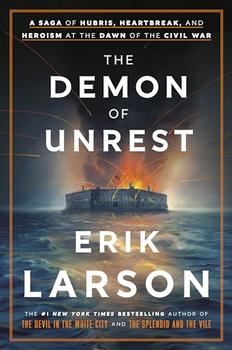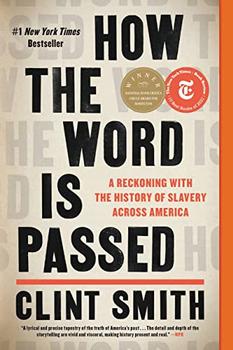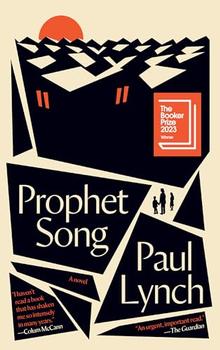Summary | Excerpt | Reading Guide | Discuss | Reviews | Beyond the book | Read-Alikes | Genres & Themes | Author Bio

A Saga of Hubris, Heartbreak, and Heroism at the Dawn of the Civil War
by Erik LarsonThe #1 New York Times bestselling author of The Splendid and the Vile brings to life the pivotal five months between the election of Abraham Lincoln and the start of the Civil War—a simmering crisis that finally tore a deeply divided nation in two.
On November 6, 1860, Abraham Lincoln became the fluky victor in a tight race for president. The country was bitterly at odds; Southern extremists were moving ever closer to destroying the Union, with one state after another seceding and Lincoln powerless to stop them. Slavery fueled the conflict, but somehow the passions of North and South came to focus on a lonely federal fortress in Charleston Harbor: Fort Sumter.
Master storyteller Erik Larson offers a gripping account of the chaotic months between Lincoln's election and the Confederacy's shelling of Sumter—a period marked by tragic errors and miscommunications, enflamed egos and craven ambitions, personal tragedies and betrayals. Lincoln himself wrote that the trials of these five months were "so great that, could I have anticipated them, I would not have believed it possible to survive them."
At the heart of this suspense-filled narrative are Major Robert Anderson, Sumter's commander and a former slave owner sympathetic to the South but loyal to the Union; Edmund Ruffin, a vain and bloodthirsty radical who stirs secessionist ardor at every opportunity; and Mary Boykin Chesnut, wife of a prominent planter, conflicted over both marriage and slavery and seeing parallels between them. In the middle of it all is the overwhelmed Lincoln, battling with his duplicitous secretary of state, William Seward, as he tries desperately to avert a war that he fears is inevitable—one that will eventually kill 750,000 Americans.
Drawing on diaries, secret communiques, slave ledgers, and plantation records, Larson gives us a political horror story that captures the forces that led America to the brink—a dark reminder that we often don't see a cataclysm coming until it's too late.
A Boat in the Dark
The oars were audible before the boat came into view, this despite a noisy wind that coarsened the waters of the bay. It was very late on a black night. The rain, according to one account, "fell in torrents, and the wind howled weird-like and drearily." In recent weeks the weather had been erratic: seductively vernal one day, bone-wrackingly cold the next. One morning there was snow. For a week a strong gale had scoured the coast. The four enslaved men rowing the boat made steady progress despite the wind and chop, and hauled their cargo—three white Confederate officers—with seeming ease. They covered the distance from Charleston to the fortress in about forty-five minutes. Until recently, a big lantern incorporating the latest in Fresnel lenses had capped the fort's lighthouse, but in preparing for war, Army engineers had moved it. Now the lantern stood elevated on trestles at the center of the enclosed grounds, the "parade," where it lit the interior ...
What are your reading this week? (12-19-2024)
The Demon of Unrest by Erik Larson
-Becky_Haase
In the aftermath of the 1860 presidential election, the divided United States began to collapse as South Carolina seceded from the Union, followed by another six Southern states. Among the countless contentious points between the Union and the fledgling Confederacy was the existence of a 75-man Federal garrison in Charleston Harbor that would become the flashpoint for civil war. In The Demon of Unrest, Erik Larson weaves a gripping tale of America's slow-motion lurch toward war, placing the reader inside events as they unfold. Covering the dicey days leading up to war, Larson's account is cinematic in scope, intimate in detail and charmingly written. Even more importantly, the parallels of 1861 with the electoral riots of 2021 make this book an urgent call to learn from history's mistakes. This is narrative history at its best: instructive, timely and utterly enthralling...continued
Full Review
 (1053 words)
(1053 words)
(Reviewed by Peggy Kurkowski).
 As Erik Larson recounts in The Demon of Unrest, the first shots of the American Civil War were fired on Fort Sumter, off the coast of South Carolina, at 4:30 a.m. on April 12th, 1861. Thirty-six hours later, Union Major Robert Anderson and his small force surrendered with no loss of life. Ironically, the only casualties sustained came during the fort's 100-gun salute when an artillery round exploded prematurely, killing Pvt. Daniel Hough and mortally wounding another. The Union would reclaim the fort four years later and Anderson would be the one to raise the same American flag the Confederates fired upon.
As Erik Larson recounts in The Demon of Unrest, the first shots of the American Civil War were fired on Fort Sumter, off the coast of South Carolina, at 4:30 a.m. on April 12th, 1861. Thirty-six hours later, Union Major Robert Anderson and his small force surrendered with no loss of life. Ironically, the only casualties sustained came during the fort's 100-gun salute when an artillery round exploded prematurely, killing Pvt. Daniel Hough and mortally wounding another. The Union would reclaim the fort four years later and Anderson would be the one to raise the same American flag the Confederates fired upon.
Today, Fort Sumter is one part of the Fort Sumter and Fort Moultrie National Historic Park, overseen by the U.S. National Park ...

If you liked The Demon of Unrest, try these:

by Clint Smith
Published 2022
The Atlantic staff writer and poet Clint Smith's revealing, contemporary portrait of America as a slave owning nation.

by Louis Bayard
Published 2020
From the prizewinning author of Mr. Timothy and The Pale Blue Eye comes Courting Mr. Lincoln, the page-turning and surprising story of a young Abraham Lincoln and the two people who loved him best: a sparky, marriageable Mary Todd and Lincoln's best friend, Joshua Speed.




A truly good book teaches me better than to read it...
Click Here to find out who said this, as well as discovering other famous literary quotes!